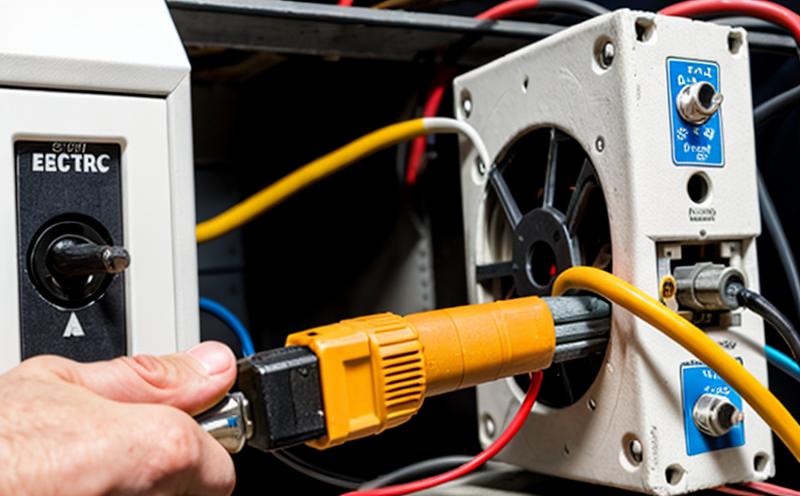IEC 61000-4-37 Power Quality Measurement for Equipment
The IEC 61000-4-37 standard is a critical tool in the evaluation of power quality in electrical systems, particularly focusing on harmonic and interharmonic disturbances. This test ensures that equipment performs reliably under varying power conditions, which is essential for maintaining high-quality service delivery in HVAC (Heating, Ventilation, and Air Conditioning) systems.
Harmonics are defined as frequency components of alternating current present in the supply network which are integral multiples of the fundamental frequency. Interharmonics are similar but occur at frequencies that are not integer multiples of the fundamental frequency. Both can cause significant issues in electrical equipment if not addressed properly. The IEC 61000-4-37 standard provides a framework for measuring these disturbances to ensure they do not exceed acceptable limits.
The testing process involves several steps which start with the initial setup where the test environment is configured according to the specified parameters outlined in the standard. This includes setting up power supplies, connecting harmonic sources, and configuring measurement equipment such as digital oscilloscopes and spectrum analyzers. Once set up, a series of measurements are taken under controlled conditions that simulate real-world scenarios.
The testing protocol involves measuring voltage and current waveforms at various points within the system, including input to the unit under test (UUT), output from the UUT, and downstream equipment. The data collected is then analyzed using both time-domain and frequency-domain techniques to identify any harmonic or interharmonic distortions present.
For HVAC systems, these tests are particularly important because they ensure that the electrical components function optimally despite potential fluctuations in power quality. This not only enhances operational efficiency but also extends the lifespan of the equipment by minimizing wear caused by suboptimal conditions.
- Customer Impact and Satisfaction: By ensuring compliance with IEC 61000-4-37, HVAC manufacturers can demonstrate their commitment to quality and reliability. This builds trust among customers who value long-term performance and low maintenance costs. Additionally, it helps in meeting regulatory requirements which is crucial for market access.
Compliance with this standard also leads to significant cost savings over time through reduced energy consumption due to improved power factor correction and minimized damage from electrical interference. Furthermore, it supports sustainable practices by promoting the use of environmentally friendly technologies that operate efficiently under varying conditions.
In summary, IEC 61000-4-37 provides a robust framework for evaluating harmonic content in HVAC systems, ensuring they meet stringent quality standards while enhancing overall system performance and longevity. This is particularly beneficial for organizations focused on delivering reliable, efficient, and sustainable solutions to their clients.
Why Choose This Test
Selecting the IEC 61000-4-37 test ensures that HVAC equipment meets stringent international standards designed specifically for electrical safety and electromagnetic compatibility (EMC). Here are some key reasons why choosing this test is advantageous:
- Accurate Measurement of Harmonics and Interharmonics: The standard provides precise methodologies for measuring harmonic content, which helps in identifying potential issues early on.
- Compliance with Regulatory Requirements: Many regions require compliance with IEC standards as part of their regulatory framework. Meeting these requirements ensures smooth market entry and operation.
- Better Equipment Performance: By testing according to this standard, manufacturers can ensure that their products perform consistently across different power quality conditions.
- Enhanced Customer Trust: Demonstrating adherence to recognized international standards enhances the reputation of both the manufacturer and end user.
- Cost Efficiency: Early detection of issues through rigorous testing reduces maintenance costs and extends product lifecycle.
These benefits make IEC 61000-4-37 an essential choice for those involved in HVAC equipment design, manufacturing, and quality assurance processes.
Competitive Advantage and Market Impact
Adopting IEC 61000-4-37 testing offers significant competitive advantages in the HVAC industry. Compliance with this standard demonstrates a commitment to quality, reliability, and sustainability, which are increasingly important factors for consumers and regulatory bodies alike.
By ensuring that their products meet these stringent standards, manufacturers can differentiate themselves from competitors offering less rigorous solutions. This not only enhances brand reputation but also opens doors to new markets where compliance with international standards is required.
The ability to provide reliable HVAC equipment that operates efficiently under varying power quality conditions provides substantial benefits for both the manufacturer and end user. It translates into higher customer satisfaction, better energy efficiency, extended product lifecycles, and reduced maintenance costs.
Moreover, this standard supports sustainable practices by encouraging the use of environmentally friendly technologies within the industry. As environmental concerns continue to grow, adhering to such standards can provide a competitive edge in an increasingly eco-conscious market.





